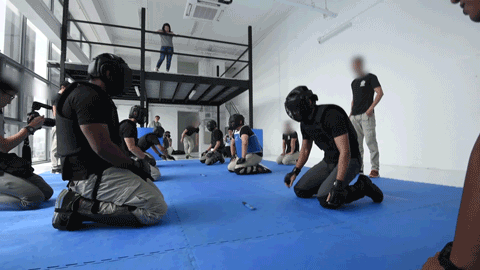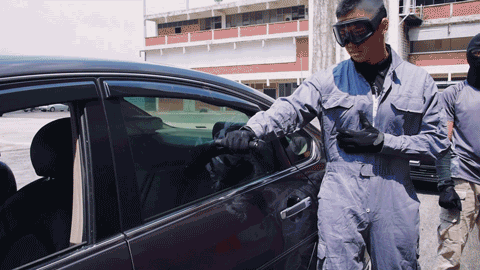SINGAPORE: The knife lies on the ground, an equal distance from me, my opponent and all 1.9m, 92kg of his muscular frame. We hurtle towards the weapon. I get there first and, naturally, try to stab him in the neck. But in a few swift, powerful moves my arm ends up hyperextended, the blade prised from my fingers and the rest of my body virtually immobilised.
It was probably a bit too easy for him, as a member of the Special Task Force (STF) unit in the Central Narcotics Bureau (CNB), Singapore’s drug enforcement agency. Drills like these – which simulate the danger of a knife attack (albeit using dummy knives) – are all in a day’s work for an elite, covert strike team trained to be the bane of drug syndicates everywhere.
Since its formation in 1997, details about the STF, such as its number of personnel, remain secret for operational reasons. But one thing is for sure – they are likely behind every high-profile, major drug seizure by CNB.
Recently the bureau decided to publicly showcase the STF in a weekly series of social media videos, “to highlight the good, tough and dangerous work that they do, putting their lives on the line to help fight for a safer and drug-free Singapore”, said a CNB spokesperson.
The clips depict skills which STF members are annually assessed on, such as forced entry, firearms marksmanship, unarmed combat and more.

But to first join the STF, CNB officers – who are all full-time “regulars” – must complete their two-year foundation postings before being eligible to apply. They are then put through a battery of physical, psychometric and scenario-based tests. Upon selection, a further three month-long conversion course awaits – and candidates must pass this to be deployed operationally.
Asked if there was a typical profile of an STF member, the unit’s senior assistant director, Superintendent William Tan, said: “Generally, everyone is physically fit, but we come in all shapes and sizes. Because of the nature of the job, we don’t wear uniform at times, so we need people who can blend into the environment – we avoid those who stand out in a crowd.”
He described an average day of an STF member as waiting by the phone to be activated.
“A operation doesn’t just happen in a single day,” Supt Tan, who has clocked eight years in the STF, explained. “There’s a build-up: We know in advance who our adversaries are, we know the ground, it’s only a question of when to hit.”
FROM SMASHING WINDOWS TO BEING SMASHED
While waiting, members do the next best thing – train. And this includes driving two cars in and out of cones with bumper to boot, plus executing movie-style reverse turns and drifts. But Supt Tan cautioned: “We don’t want them to drive like this on the road. The training is for them to have better control and handling of the vehicle.
Skid marks evident from rounds and rounds of training in vehicle movement (Photo: Howard Law)
“A lot of it is instilling teamwork too, when we have several vehicles on the road, they must have confidence and understanding in each other.”
After intercepting a suspect’s vehicle, the next step often involves smashing windows.
“The door will be locked – we won’t have the most cooperative suspect who will open and surrender, so they have to experience that in training,” Supt Tan explained.
I got to do so, as well, when they handed me a baton and taught me to use its tough, tempered base to shatter the glass with just one hit.

This, and being a passenger in a spinning, screeching car, was good fun. Playing a suspect sitting inside and struggling against arrest – less so.
“Inside the car, in that confined environment, often they have weapons hidden so we must prepare for all these scenarios,” said Supt Tan. They were prepared alright – moving in fast and fluid to pin my head, arms and legs before cuffing and dragging me out of the vehicle.
I told them not to go easy on me – a rather regrettable move.
More helplessness was in store when I was given a taste of their close-quarter defence training, which takes up an entire third of the aforementioned three-month conversion course.
STF members do not learn a specific fighting system but rather a pick and mix of suitable elements from different styles. The training equips them to fend off attacks by both unarmed individuals as well as those wielding weapons – such as knives.
Cue the knife scramble exercise: Whether as aggressor or defender, over and over I was outsmarted and outmanoeuvred by my STF partner, leaving me with a sprained thumb and multiple aches and abrasion.
The one time I got the better of him. Yes, he let me (Photo: Gaya Chandramohan)
“We have our vocal commands, we have our hands, we have our baton, our firearm. Depending on the level of aggression we’re facing, we will use an appropriate level of force to apprehend – one that is not excessive,” said Supt Tan.
He added that the training also simulates dealing with individuals who may be under the influence of drugs and thus stronger or even “immune to pain” – by having members practice taking on someone fully suited up in pads.
READY FOR THE WORST
For Supt Tan, the STF has taken on increasing relevance today. “We need to be specialised in skills and tools to handle drug syndicates which are more sophisticated and innovative than before – in the technology they use and the way they do transactions,” he noted.
Over 17 years in CNB, he has trained for and participated in his fair share of operations, where suspects aggressively attempting to evade arrest – including one armed with a crowbar – are “part and parcel” of the job.
The one time he and his team were taken by surprise: A case where they had to apprehend suspects and ensure the safety of a toddler at the same time.
Perhaps no amount of training can stop one from expressing shock at such a scenario – but otherwise, the STF remains devoted to preparing for the worst cases, said Supt Tan.
The dreaded 14-station “circuit” test to end their month-long unarmed combat training is an excruciating example of this.
I underwent a watered-down version with half the number of stages, but boy was it tough: In between sparring and doing burpees plus jumping jacks, groups of at least four men were roughhousing and boxing me in with giant pads – while other STF members stood around screaming, shouting and banging objects to recreate the utter chaos and confusion of a possible real-life operation.
At the final station I had to fend off a fully padded-up STF member using a baton. I couldn’t feel my arms then (Photo: Gaya Chandramohan)
“We won’t see people tapping out or giving up, but one typical sight is them throwing up,” Supt Tan smiled.
“To ask someone to do a drill in normal circumstances, anybody can. But under duress, fatigue and exhaustion – that’s where we see who still can perform and who will fumble under pressure … The circuit helps us understand the individual.”
It’s true. Completely winded by the second stage, and barely able to breathe and stand by the last, there and then I understood perfectly why my namecard spelt “journalist” and not “Special Task Force”.




